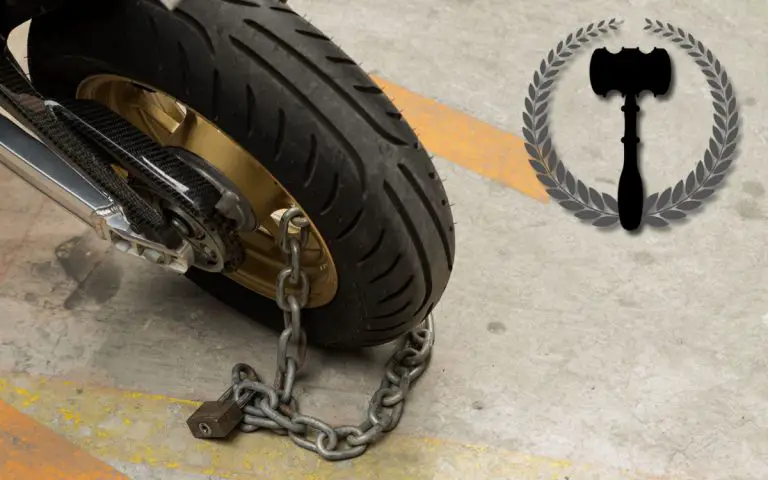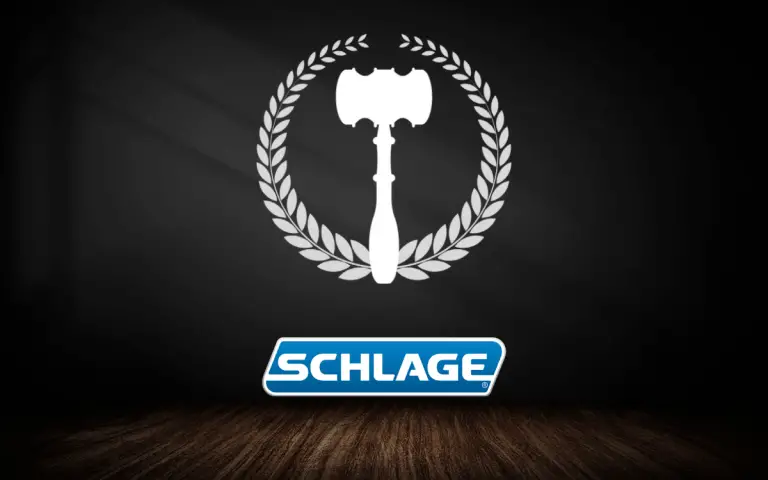19 Expert Tips: Lock Lubricants, Lock Care & More
Locks play a pivotal role in safeguarding our valuable assets, yet their maintenance often falls by the wayside. This guide serves as a comprehensive resource on lubricants for locks and lock care, highlighting the need for regular upkeep and the role of lubricants in enhancing the longevity and functionality of your locks.
Next is a list of the best lock lubricants for door locks and all other types of locks, then we will explain how to use them, the importance of lock maintenance and finally how the lubricants work.
Types of Lock Lubricants
The type of lubricant you choose for your lock can significantly impact its performance and longevity. Here’s a look at some common types of lock lubricants and when to use them:
Graphite Powder
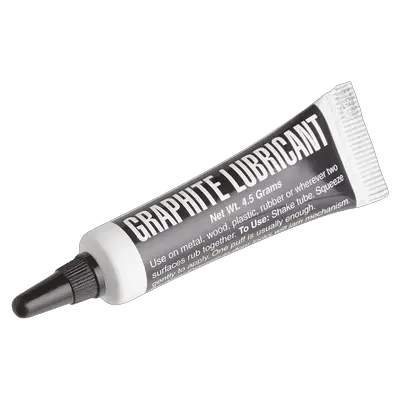
Pros and Cons
Graphite powder is the classic choice for lock lubrication due to its non-sticky nature. It doesn’t attract dust or grime, which can prolong the cleanliness and functionality of the lock. However, graphite is not recommended for use in locks that are exposed to extreme cold, as it can clump together and cause the lock to jam.
When to Use
Graphite powder is ideal for indoor locks or locks in temperate climates where the risk of clumping is low. It’s also an excellent choice for high-security locks, as its smooth consistency can enhance the precision of the lock mechanism.
*Paid Links
Houdini Lock Lube
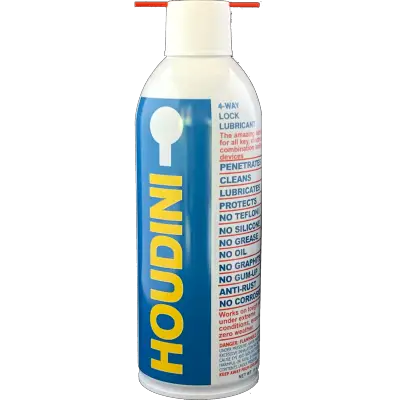
Pros and Cons
Houdini Lock Lube is a premium lubricant with a reputation for its rapid action and versatility. Known for its effectiveness on a wide variety of locks, it’s a reliable choice for many lock care needs.
When to Use
Given its broad-ranging effectiveness, Houdini Lock Lube is well-suited for an array of scenarios. It shines when used on locks that undergo frequent use or are subjected to harsh conditions due to its persistent protective action.
It’s also perfect for locks starting to stick or display signs of wear, as its prompt action can help prevent further deterioration. Bear in mind, for sensitive or specialized locks, it could be beneficial to seek professional advice or check the lock manufacturer’s recommendations.
*Paid Links
Teflon and Other Synthetic Lubricants

Pros and Cons
Teflon (PTFE) and other synthetic lubricants offer excellent performance across a wide temperature range. They don’t attract dust and grime, keeping the lock clean and smoothly operational. However, they are generally more expensive than other types of lubricants.
When to Use
Given their broad temperature compatibility, synthetic lubricants are suitable for both indoor and outdoor locks. They’re also a good choice for locks with complex mechanisms that need high-performance lubrication.
*Paid Links
Silicone-based Lubricants
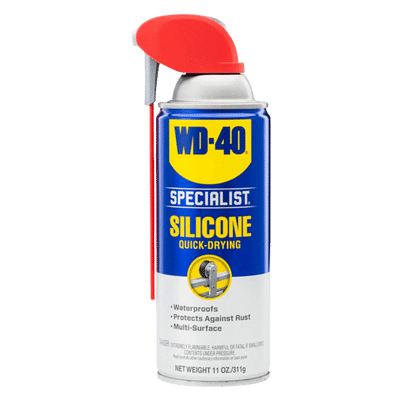
Pros and Cons
Silicone-based lubricants are water-resistant, making them an excellent choice for outdoor locks. They don’t dry out or get sticky, ensuring a consistent performance. On the downside, silicone lubricants can sometimes attract dust, which might require more frequent cleaning and reapplication.
When to Use
Silicone-based lubricants are best for locks exposed to the elements, such as padlocks or exterior door locks. They’re also useful for locks in humid environments, thanks to their water-resistant properties.
*Paid Links
WD-40 and Other Penetrating Oils
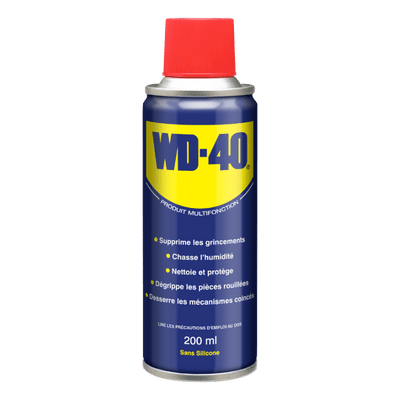
Pros and Cons
WD-40 and similar products are excellent for freeing stuck mechanisms and providing temporary lubrication. However, they are not designed to be long-term lubricants. Over time, they can attract dust and grime, leading to a sticky residue that can interfere with the lock’s operation.
When to Use
WD-40 or other penetrating oils should be used for dealing with a jammed or rusted lock. They can help free up the mechanism, but after their use, it’s important to properly clean the lock and apply a suitable long-term lubricant for ongoing maintenance.
In the next section, we will provide a step-by-step guide on how to lubricate your lock, ensuring the best care for its specific type and usage.
*Paid Links
How to Apply Lock Lubricant
Applying lubricant to a lock requires a careful approach to ensure the lubricant effectively reaches the necessary components without causing damage or unnecessary mess. Below, you’ll find steps for lubricating different types of locks, some safety precautions, and common mistakes to avoid.
Steps for Lubricating Different Types of Locks
While the basic principle remains the same — getting the lubricant into the lock mechanism — the process can vary slightly based on the type of lock and the type of lubricant.
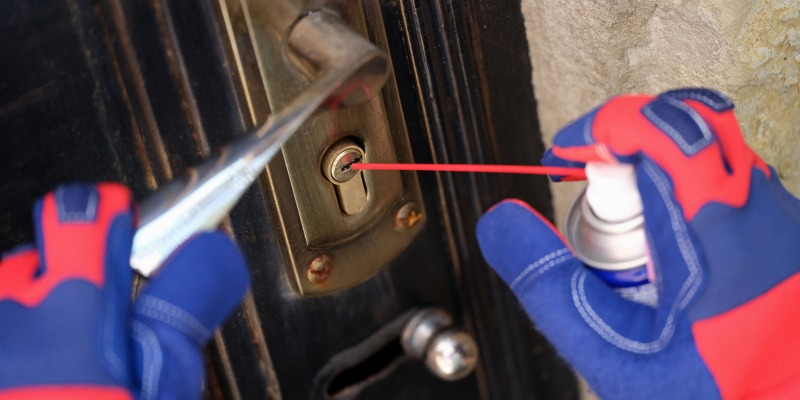
Padlocks and Deadbolts
If using a spray lubricant, attach the straw to the nozzle.
Insert the tip of the straw (or nozzle of a dropper or tube for non-spray lubricants) into the keyhole.
Apply a small amount of lubricant.
Insert the key and turn it back and forth several times to distribute the lubricant inside the lock.
Knob Locks
Similar to padlocks and deadbolts, start by inserting the straw or nozzle into the keyhole and applying the lubricant.
If the knob is hard to turn, consider lubricating the latch mechanism. Remove the knob (if possible), locate the latch mechanism, and apply a small amount of lubricant.
Safety Precautions
- When using spray lubricants, ensure the area is well-ventilated to avoid inhalation of fumes.
- Always wear eye protection to prevent any accidental spray into your eyes.
- Keep lubricants out of reach of children and pets.
Common Mistakes to Avoid
- Over-lubrication: This can lead to a buildup of excess lubricant, which can attract dust and grime. Always start with a small amount and only add more if necessary.
- Using the wrong type of lubricant: As discussed earlier, different locks and environments require different types of lubricants. Always ensure you’re using the right lubricant for your specific lock.
- Not cleaning before lubricating: Applying new lubricant over old, dirty lubricant can lead to a sticky, messy buildup. Always clean the lock before applying new lubricant.
By adhering to these steps and precautions, you can keep your locks working smoothly, enhancing their lifespan and security. In the following section, we will discuss the importance of regular lock checks and provide tips on how to spot potential issues.
Importance of Lock Maintenance
Understanding lock mechanisms, particularly the dynamics of lock picking, is fundamental to effective lock care. When well-maintained, the internal components of a lock, like the pins, move freely, making the lock more secure. By contrast, a neglected lock may become an easy target for lock pickers due to jammed or sticky pins. Regular lock maintenance is, therefore, a critical step in securing your property and extending the life of your locks.

Common Issues with Neglected Locks
A lack of proper maintenance often leads to locks jamming, seizing, or even failing entirely. Besides these operational issues, neglected locks may also pose security risks, becoming more susceptible to lock picking.
This guide will delve into the various aspects of lock care and lubrication, arming you with the knowledge needed to avoid these common issues and ensure the long-term reliability of your locks.
Understanding Lock Mechanisms
Delving into the world of lock care necessitates a basic understanding of how locks work. Familiarity with the different lock mechanisms not only allows for better maintenance but also enhances your ability to identify potential security risks.
Basic Lock Components
At their core, most locks comprise similar components that need to be lubricated for the lock to function. The most common is the pin tumbler lock, which consists of the following parts:
- Plug: This is the cylindrical part that turns when the correct key is inserted.
- Pins: These consist of key pins (which touch the key when inserted) and driver pins. The correct key will align these pins at the shear line, allowing the plug to rotate.
Understanding these components and their roles is crucial for successful lock maintenance and care.
How Locks Work
When the correct key is inserted into the lock, it pushes the key pins to the correct height, aligning them with the driver pins at the shear line. This alignment allows the plug to rotate freely, unlocking the lock. If the incorrect key (or no key) is inserted, the pins won’t align correctly at the shear line, and the plug won’t turn.
A lock that is properly maintained will have pins that move smoothly and freely, which is essential for both everyday operation and security. Regular lubrication can aid in this smooth movement, preventing sticking or jamming that could potentially compromise the lock’s security.
Types of Locks: Padlocks, Deadbolts, Knob Locks, etc.
Locks come in many different forms, each with distinct mechanisms and lubrication needs. Here’s a closer look at some common lock types and how they should be lubricated:
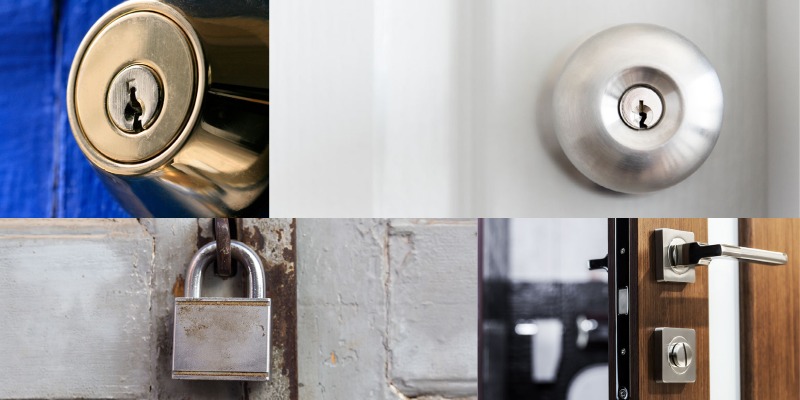
- Padlocks: These are portable and free-standing, often used in outdoor conditions which may require more frequent lubrication. A graphite or silicone-based lubricant can typically be applied directly through the keyhole, ensuring the pins inside remain free-moving and resistant to rust.
- Deadbolts: Known for their high security, deadbolts are common on exterior doors. The lock mechanism is more complex compared to some other types. While it is possible to apply lubricant through the keyhole, removing the lock cylinder, if comfortable doing so, can allow for more thorough lubrication of the pin tumblers. Additionally, the bolt mechanism itself, which slides into the door frame, can benefit from a touch of lubricant to ensure smooth operation.
- Knob Locks: Regularly found on interior doors, these locks house the lock mechanism within the knob. A small amount of lubricant can be applied directly into the keyhole. Similarly to the deadbolt, if the knob is hard to turn, a little lubricant can be applied to the latch mechanism which interfaces with the door frame.
As always, the primary aim of lubrication is to maintain smooth operation across different types of locks, enhancing their longevity and security. In the following sections, we’ll further unpack the role of lubricants and how to select the best one for your lock.
Other Lock Care Practices
While lubrication plays a vital role in lock maintenance, it’s just one piece of the puzzle. Regular cleaning, inspections for wear and tear, and proper installation are also critical aspects of comprehensive lock care.

Regular Cleaning of Locks
Regular cleaning helps maintain the functionality and longevity of your locks by removing grime, dust, old lubricant, and any other debris that might interfere with the lock mechanism.
- Why Clean a Lock?
Cleaning a lock can help prevent the pins from sticking, ensure the key turns smoothly, and reduce wear and tear. Furthermore, cleaning can also reveal any signs of wear or damage that might otherwise go unnoticed. - How to Clean Different Types of Locks
For all locks, start by using a compressed air duster to blow out dust and debris from the keyhole. Then, apply a lock cleaner or quick-drying cleaner and insert the key, turning it several times to distribute the cleaner. Finally, let the lock dry thoroughly before applying new lubricant.
For knob locks or locks with accessible latches, consider cleaning the latch mechanism using a small brush or cloth and a suitable cleaner. Be sure to let it dry completely before reapplying the lubricant.
Regular Inspection for Wear and Tear
Regularly inspect your locks for signs of wear and tear, such as rust, visible damage to the lock or key, difficulty turning the key, or the lock sticking. These could be signs that the lock needs maintenance or replacement.
When to Replace a Lock
While regular maintenance can prolong the life of a lock, all locks eventually need to be replaced. Signs that a lock may need to be replaced include consistent difficulty turning the key, visible damage or wear, or if the lock no longer provides adequate security. If you’re in doubt, consult with a professional locksmith.
Proper Installation to Prevent Early Wear
Proper installation is essential to prevent premature wear and ensure the lock operates smoothly. A poorly installed lock may not close properly, could cause unnecessary strain on the mechanism, or might not provide adequate security. Always ensure that locks are installed correctly, and if you’re not confident doing it yourself, consider hiring a professional locksmith.
By combining these practices with regular lubrication, you can help ensure your locks remain in top condition, providing security and peace of mind. In the final section, we’ll discuss some extra tips for maintaining high-security locks.
The Role of Lubricants in Lock Maintenance
Lubricants are instrumental in keeping your lock working smoothly and enhancing its lifespan. They reduce friction within the lock mechanism, ensuring that the pins and tumblers move freely and the key turns easily in the cylinder. Let’s delve deeper into the reasons for lubricating a lock, the frequency, and the distinction between lubrication and cleaning.

Why Lubricate a Lock?
Lubricating a lock is a key aspect of lock maintenance. It helps in several ways:
Reduces Friction: Lubricants help the internal components of the lock move against each other smoothly, reducing wear and tear.
Prevents Sticking: They prevent the pins within the lock from sticking, ensuring the key can turn easily.
Protects Against Rust and Corrosion: Lubricants can provide a layer of protection against moisture, reducing the risk of rust and corrosion, particularly for outdoor locks.
How Often Should You Lubricate a Lock?
The frequency of lock lubrication can depend on the type of lock and its location. Outdoor locks or locks used frequently may require lubrication every 3-6 months.
However, for interior locks or those used less often, lubricating once a year may be sufficient. It’s also advisable to lubricate a lock after any cleaning process or when you notice the lock or key is not turning as smoothly as it should.
Difference between Lubrication and Cleaning
While both cleaning and lubrication are essential parts of lock maintenance, they serve different purposes and should be carried out separately.
Cleaning a lock involves removing dirt, grime, and old lubricant from the lock mechanism. This can be done with a lock cleaner or by flushing with a quick-drying cleaner like electrical contact cleaner. Cleaning ensures that the lock mechanism is free from any debris that could interfere with its operation.
Lubrication, on the other hand, comes after cleaning and involves applying a suitable lubricant to the lock mechanism. The lubricant reduces friction, prevents sticking, and protects against rust and corrosion. Remember, it’s important not to mix cleaning and lubrication in a single step — a cleaner can remove lubricant, and some lubricants can attract and hold dirt, defeating the purpose of cleaning.
Up next, we’ll explore different types of lubricants, their pros and cons, and their appropriate uses.
Professional Lock Care Services
There are times when lock maintenance can go beyond the scope of DIY care. Whether it’s a complex high-security lock, a lock in need of replacement, or a persistent issue that basic maintenance hasn’t resolved, professional locksmith services can be invaluable.

When to Call a Professional
Certain circumstances warrant the need for a professional locksmith:
- Lock Replacement: If a lock is worn out, damaged, or no longer providing sufficient security, a professional can ensure a new lock is installed correctly and safely.
- Persistent Issues: If a lock is sticking, the key is difficult to turn, or other issues persist despite cleaning and lubrication, a professional can diagnose and fix the problem.
- High-Security or Complex Locks: These locks have more intricate mechanisms that may require specialist knowledge to maintain and repair.
- Lockouts: If you’re locked out of your home, a locksmith can help you gain entry without damaging the lock or door.
What to Expect from a Professional Locksmith
A professional locksmith should be able to quickly diagnose any issues with your locks and provide a clear explanation of the required services. They can perform a variety of tasks, including lock installations, repairs, key cutting, and more. It’s important to ensure the locksmith you hire is reputable, licensed, and insured to guarantee a high-quality service.
Additionally, many locksmiths offer maintenance services, which can be particularly useful for commercial properties with many locks or for homeowners who want to ensure their locks remain in top condition.
In conclusion, while regular at-home lock care is essential, don’t hesitate to call in a professional when needed. By combining regular cleaning and lubrication with professional services when necessary, you can ensure your locks provide reliable security for years to come.
Conclusion: Key Takeaways for Effective Lock Care
Through this exploration of lock care, we’ve discovered the complexities of lock mechanisms, the important role of lubricants, and the practices that keep our locks functioning at their best.
Summary of Lock Lubricants and Their Uses
We’ve learned about different types of lubricants — graphite powder, synthetic lubricants like Teflon, silicone-based lubricants, and penetrating oils like WD-40 — each with their unique advantages and ideal uses. Whether you have a simple indoor knob lock or a complex high-security lock exposed to the elements, choosing the right lubricant is crucial in maintaining smooth operation and prolonging the life of your locks.
Importance of Regular Lock Maintenance
Regular cleaning and lubrication are at the heart of effective lock care. By cleaning your locks to remove grime and old lubricant, then applying fresh lubricant, you reduce friction, prevent sticking, and protect against rust and corrosion. Regular inspections are also crucial for detecting early signs of wear and tear, allowing you to address minor issues before they become significant problems.
Final Tips and Advice
Don’t underestimate the importance of proper installation and consider professional locksmith services for tasks beyond your expertise. It’s better to invest in professional assistance than risk damaging your locks or compromising your security.
In summary, effective lock care is a mix of choosing the right lubricant, regular cleaning and lubrication, periodic checks for wear and tear, and knowing when to call a professional. By implementing these practices, you’re investing not only in the longevity of your locks but also in the security and peace of mind they provide.




